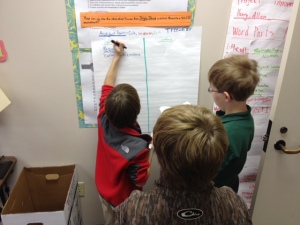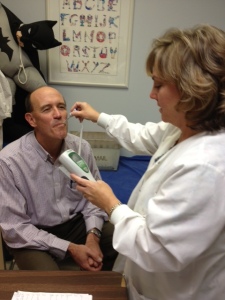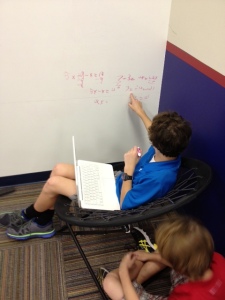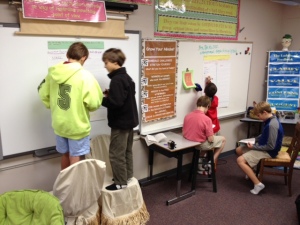I spent most of my third day at Presbyterian Day School in the early childhood wing, with a reading group that could be a model for any grade level and the technology group. I also revisited the Learning Studio, the heart of what appears to be a revolutionary method of differentiated learning. Here are some mini-reports from each of these areas that touch on reading, systems thinking, early childhood, technology in the classroom, report cards, faculty self-assessment, and more.
 The 5th grade reading class started their day by kicking off their shoes and quickly going next door to another 5th grade classroom for a brainstorming “warm-up” exercise. It is a song and dance that reminds the students to pursue fluency, inclusion of ideas, wild ideas, and lateral thinking as they investigate their reading. Back in their own classroom, the students got down to work, breaking into groups, each at a different wall. The task they had designed (that’s right, not designed by the teacher), was to jointly read a book, and then take their understanding, ideas, and clues of character traits and build a solid three-dimensional monument based on color, symbols, and image. Sound abstract? It is; they are converting ideas into solid 3D objects. The teacher, Alice Parker, and the students transcribed the idea from a previous project in which they represented a book on the Holocaust by building chairs. (They are now going to sell the chairs and are deciding how to donate the funds.) There is no front of the class; Alice roams the room, prodding and asking questions, but leaves the real work to the students. They are used to this; they mark up their reading books with color-coded notes of connections, predictions, conflicts, and summary ideas. They write questions and arguments at the end of chapters that represent alternate and arguable viewpoints. They push each other as they brainstorm at the walls. The products will be a building project and a piece of reflection writing that allows the students to express both what they did and how they feel they conducted themselves in the process. What does our 5th grade reading class look like?
The 5th grade reading class started their day by kicking off their shoes and quickly going next door to another 5th grade classroom for a brainstorming “warm-up” exercise. It is a song and dance that reminds the students to pursue fluency, inclusion of ideas, wild ideas, and lateral thinking as they investigate their reading. Back in their own classroom, the students got down to work, breaking into groups, each at a different wall. The task they had designed (that’s right, not designed by the teacher), was to jointly read a book, and then take their understanding, ideas, and clues of character traits and build a solid three-dimensional monument based on color, symbols, and image. Sound abstract? It is; they are converting ideas into solid 3D objects. The teacher, Alice Parker, and the students transcribed the idea from a previous project in which they represented a book on the Holocaust by building chairs. (They are now going to sell the chairs and are deciding how to donate the funds.) There is no front of the class; Alice roams the room, prodding and asking questions, but leaves the real work to the students. They are used to this; they mark up their reading books with color-coded notes of connections, predictions, conflicts, and summary ideas. They write questions and arguments at the end of chapters that represent alternate and arguable viewpoints. They push each other as they brainstorm at the walls. The products will be a building project and a piece of reflection writing that allows the students to express both what they did and how they feel they conducted themselves in the process. What does our 5th grade reading class look like?
Next stop was the 4-year old Mandarin classroom, the second year of Mandarin for these students. I did not understand a single word, but the little kids did, singing songs and re-enforcing vocabulary about colors, numbers, and family members. Later in the day I learned that 5th graders had a fried rice cook-off, presenting in Mandarin to teachers and visitors as they prepared the food.
An SK class was working on their class blog. They sit in front of the Smartboard with the teacher driving and brainstorm ideas for a new post. Get this: in the last four months they have had more than 4,600 views of their class blog from all over the world. So they choose a few recent visitors, Google images and news from those countries, surf new knowledge for 20 minutes, and then use those new learnings to help drive where they want to go for their next class post. They visited Turkey and Belgium, asked some questions about those countries, and of course will follow up later by posting back to those visitors on their own sites. These are five-year olds. In the adjacent SK class, the students were in four different groups: one typing their own blogs on laptops; a second working differentiated math problems/games on iPods with headphones; a third working through a self-paced reading program on laptops; and the fourth brainstorming with the teacher on a story breakdown to find multiple viewpoints. Did I already say that these students are not even in 1st grade yet?
I spent an hour with the Technology Coordinators at PDS, and this summary is going to be general, primarily because there is so much going on that I could not keep up. The group is sending me some information that I will post tomorrow with direct links to student outcomes, and those pictures will be worth more than all my words.
PDS is in about the 5th year of serious technology integration in the classroom, and even teachers who might have been labeled ‘resistors’ a year or two ago are now using Haiku to manage their classrooms and student interactions. There is a clear expectation in the faculty evaluation system that teachers need to try new technology and to become increasingly connected both internally and externally for their own professional development. PDS very much believes that technology is not the end, but merely the portal to new educational relationships that enhance both the experience and the outcomes for their students. The tech group has led the way, organizing the InnovatED un-conference-style program last year at PDS, where more than 350 educators from the Memphis area met in person with others joining in on Skype and online, holding 45 sessions related to use of technology in the classroom. They are planning another similar program this year.
Here are a few more examples of how PDS is using technology in new ways:
- 2nd graders went to the Memphis Zoo and built a scavenger hunt game on their iPods for the trip. Small groups took turns at each stop on the hunt asking questions and shooting video. When they got back they made movies and wrote reflection pieces about their outing.
- 3rd grade math classes are using Voice Thread for student work so teachers can both see and hear how the students are working problems. Rather than just correcting a worksheet, the teacher quickly scrolls through each students’ work, stops at an incorrect answer, reviews how the student went wrong, and can then record a response specific to that student, who can log on anytime, anywhere, and see/hear the teacher’s personal message. The license for this capability costs $1 per student.
- In 4th grade the students start to use Google Sites to learn about digital literacy and appropriate use of social media. In 5th grade they are each building sites, which they own and manage. They have a Book Club in which they learn how to file, post, create video, share, and comment on each other’s work. Each 5th grader also contributes to his report card by creating a video self-portrait, reflecting on his own traits of character; these are burned to a CD for the parents.
- Faculty also share their own self assessments with colleagues. Each year they post and update their own goals and can add Voice Threads, all of which are open to the full faculty. Teachers are encouraged to review each other’s goals and PD plans, comment, and share as the year goes on.
The PDS Tech team has built some impressive software to map the progress of each student through their highly differentiated instruction program. At this point the product is proprietary, but I expect them to be rolling it out at some point in the not distant future. And, as I said, check back in the next day or so for more specific links.
One reason PDS is making such enormous strides in student-centered learning is that they are one of the most fluid school environments I have seen, and I believe that fluidity is a critical characteristic of true innovation. Teachers move around the classroom and between classrooms. I could not walk down a hall without seeing two teachers or a small group talking together. Students don’t sit in desks; they are constantly moving around in their own classrooms, or off to the Learning Studio or another learning node. Fluidity breeds connections and connections breed communication, the percolation of ideas, innovation, trials, and new directions. If you see wasted motion here, you are wrong; this motion is the visible manifestation of knowledge creation, and that, not consumerism, is what education should be about.







[…] Fluidity Breeds Engaged, Highly Differentiated Learning at Presbyterian Day School, December 2, 2012 […]